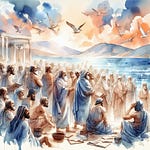Exodus 25-28: The Blueprint for the Tabernacle
Exodus 25: The Sacred Offering and the Ark of the Covenant
The Lord called Moses to Him once again, His voice steady with purpose.
"Moses," He said, "tell the Israelites to bring Me an offering. It must come from those whose hearts are willing. These are the gifts they should bring: gold, silver, bronze; fabrics of blue, purple, and scarlet; fine linen and goat hair. They should bring ram skins dyed red, fine leather, acacia wood, oil for the lamps, fragrant spices for anointing oil and incense, and precious onyx and gemstones for the priestly garments."
The Lord’s command was clear: "Build Me a sanctuary so that I may dwell among My people. Follow the exact pattern I will show you for the tabernacle and all the sacred items within it."
Moses listened intently as God described the construction of the Ark of the Covenant.
"You shall build it from acacia wood, two and a half cubits long, one and a half cubits wide, and the same in height. Overlay it inside and out with pure gold, and place a gold molding around its edges. Forge four golden rings and attach them to its corners—two on each side. Craft poles of acacia wood, overlay them with gold, and slide them through these rings to carry the Ark. These poles must never be removed."
Inside the Ark, Moses was instructed to place the testimony that God would give him. Then, atop the Ark, there was to be a mercy seat made entirely of pure gold. God’s voice remained steady as He described the cherubim.
"Make two cherubim of gold, crafted by a skilled artisan. Place them at either end of the mercy seat, with their wings spread upward, overshadowing it. Their faces shall look toward each other, gazing down upon the mercy seat."
The Lord then made a promise. "There, above the mercy seat, between the cherubim, I will meet with you and give you My instructions for Israel."
The conversation continued as God described a sacred table to hold the bread of His presence and an ornate golden lampstand to illuminate the tabernacle. Each branch of the lampstand was to be carefully designed, resembling almond blossoms, with cups and buds shaped with precision. "Place seven lamps upon it," God instructed, "so that its light shines forward in the tabernacle."
Exodus 26: The Tabernacle’s Sacred Design
God's instructions continued, unveiling the intricate details of the tabernacle itself.
"Make ten curtains of fine linen, embroidered with blue, purple, and scarlet thread. Skilled craftsmen must weave cherubim into the fabric. Each curtain must be exactly twenty-eight cubits long and four cubits wide, and all should be joined together with gold clasps, forming a single unit."
To shield the holy structure, God instructed Moses to prepare additional coverings—one made of goat hair, another of ram skins dyed red, and an outermost layer of fine leather.
Then came the framework. "Make upright boards from acacia wood, each ten cubits tall and one and a half cubits wide. These boards will stand on silver bases and be connected by wooden crossbars, all overlaid in gold. Arrange twenty boards along the southern and northern sides, with six at the western end, and two extra for the rear corners."
Moses envisioned the grand sanctuary as God described its final feature: a thick veil, intricately woven in blue, purple, and scarlet, embroidered with cherubim. "Hang this veil from four gold-covered pillars. Behind it shall stand the Ark of the Covenant, separating the Holy Place from the Most Holy Place."
Exodus 27: The Bronze Altar and the Courtyard
The Lord’s instructions turned to the outer court of the tabernacle.
"Build an altar of acacia wood, five cubits wide and five cubits long—a perfect square. Its height shall be three cubits. Place horns at each corner, and overlay the entire altar with bronze. Craft bronze utensils for it—ash pans, shovels, basins, forks, and firepans."
Beneath the altar, a bronze grating with rings on its sides was to be installed. Staves of acacia wood, covered in bronze, would be inserted into these rings for transport.
Beyond the altar, the courtyard of the tabernacle would be enclosed by fine linen curtains, stretching one hundred cubits on the northern and southern sides, and fifty cubits on the eastern and western ends. Bronze posts with silver hooks would hold the curtains in place. The grand entrance was to be adorned with a woven screen of blue, purple, and scarlet, supported by four posts.
Finally, God commanded the people to provide pure beaten olive oil for the golden lampstand so its light would burn continually. "Aaron and his sons shall tend it every evening and morning, a lasting ordinance for the generations to come."
Exodus 28: The Priestly Garments
The Lord then turned to Aaron and his sons, choosing them as His priests. "Prepare sacred garments for Aaron—for glory and beauty," He instructed Moses.
Skilled artisans would craft the garments:
A breastplate, an ephod, a robe, a tunic of woven linen, a turban, and a sash.
The ephod was to be woven of gold, blue, purple, and scarlet yarn, its shoulder pieces fastened together with golden settings. Two onyx stones, engraved with the names of Israel’s twelve tribes, were to be placed upon the shoulders as a reminder before the Lord.
The breastplate was to be a masterpiece of fine craftsmanship, adorned with twelve gemstones—one for each tribe of Israel. Arranged in four rows, these stones included the sardius, topaz, emerald, sapphire, diamond, and more. This breastplate, containing the sacred Urim and Thummim, would rest over Aaron’s heart whenever he entered the Holy Place, bearing the judgment of Israel before the Lord.
The robe of the ephod was to be made entirely of blue fabric, its hem decorated with golden bells and woven pomegranates. "Aaron must wear this robe when he ministers, so that its bells may be heard as he enters and exits My presence, lest he die," God warned.
Additionally, a golden plate, engraved with the words HOLINESS TO THE LORD, was to be fastened to Aaron’s turban. "It shall be upon his forehead always," God decreed, "so that the offerings of Israel may be accepted."
Lastly, Moses was instructed to provide tunics, sashes, and head coverings for Aaron’s sons, ensuring they, too, were clothed in garments of holiness. Even their undergarments were specified, covering them from waist to thigh to preserve their dignity before God.
"This shall be a lasting command," the Lord concluded, "for Aaron and his descendants after him."
As Moses stood on the mountaintop, listening to every word, he marveled at the divine precision with which God had designed His dwelling place. Every element—from the Ark of the Covenant to the priestly robes—was a symbol of holiness, set apart for the presence of the Almighty. Soon, the people of Israel would begin their sacred work, constructing a place where heaven would meet earth, where God Himself would dwell among them.












Share this post